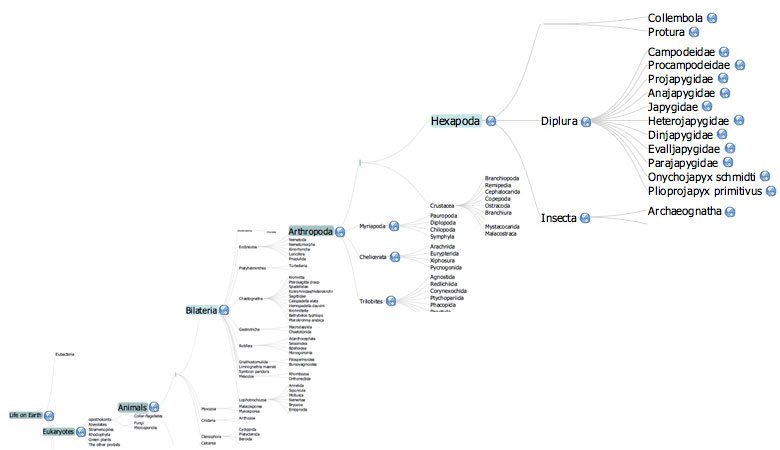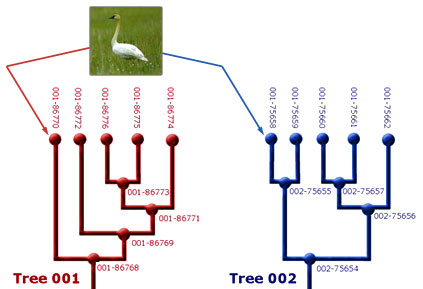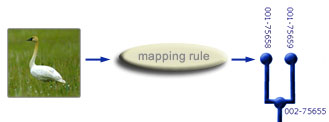ToL History/Future
Future of the Tree of Life Project
We are gradually expanding the information provided on the ToL website, and we are continuously implementing new features. Here are some projects we are currently working on and some we have planned for the future.
Developing New ToL Branches
- Update nomenclature and tree structure for the ToL fungi branch and develop pages for major groups of fungi, in collaboration with the Assembling the Fungal Tree of Life project.
- Development of the ToL Lepidoptera branch, including pages for all species of butterflies, in collaboration with the LepTree AToL project.
- Pages for all specis of amphibians, in collaboration with AmphibiaWeb and the AmphibiaTree AToL project.
- Development of ToL protist branches, in collaboration with micro*scope/uBio.
- Pages for all species of birds. David Mindell, John Harshman, Frank Gill, Scott Lanyon, in collaboration with the Early Bird and Historical Inference in the Emberizinae AToL projects.
- Development of the ToL Actinopterygii branch. John Lundberg, E. 0. Wiley, G. David Johnson in collaboration with the Deep Fin Research Coordination Network.
- Development of the ToL dinosaurs branch. Paul Sereno.
- Development of the ToL Coleoptera branch, in collaboration with the BToL project.
- Development of the ToL Hymenoptera branch, in collaboration with the HymAToL project.
- Development of the ToL Diptera branch, in collaboration with the FLYTREE project.
Developing the ToL Media Collection
- Create web services that let people/projects download parts of the ToL media collection. Collections for any branch of the tree will be made available based on licensing terms; i. e., anybody will be able to download public domain and creative commons images and their data. ToL partner projects will be able to also download media files that have been released under the "Use on ToL and share with other scientific/educational projects" license.
Sharing Data With Other Collections
- Import content from AmphibiaWeb for the leaf pages of the living ampibians branch of the ToL.
- Export content (tree structure, taxonomic names, media files, page content) from the ToL Lepidoptera branch to the LepTree AToL project.
- Integrate ToL image collection and services with Morphbank.
Dynamic Tree Viewer/Navigator
- A dynamic tree viewer that will let ToL
visitors navigate the tree structure and zoom in on different
branches.

Communication/Interaction Tools for ToL Visitors and Contributors
Forums, comments, user ratings, etc.
Customizing ToL Content
ToL visitors will be able to customize the content and format of ToL pages according to their own needs. See Customizing Your View of the Tree of Life
Alternative Tree Structures
Looking further into the future, development efforts will focus on adapting
the ToL information
architecture so that ToL content can be displayed in the context
of alternative tree structures. Currently, the backbone for the ToL
Web Project is provided by a single human synthesis tree, and all materials
in the ToL database are represented by objects that are attached to particular
nodes in this tree. In the current information architecture, this attachment
is direct, i. e., for each object, there is an entry in the database
specifying
Object A is attached to Node X. If we want to
support multiple alternative tree structures, each object will have to
be attached to equivalent nodes in different trees. 
The
challenge is to find
a way to automatically identify proper nodes of attachment
for objects if the underlying tree structure changes. Different
trees may use different names for equivalent nodes, a node
may have been moved to a different position in the tree,
and a node may have different descendents in different trees.  In order
to attain flexibility in the attachment of objects, while
at the same time maintainig precision in the relevance of
attachments, ToL objects will in the future be attached to
nodes via a mapping rule. The mapping rule will specify a
node or nodes to which the object is attached. The mapping
rule might be as simple as "Attach
Object A to this specific node in this particular tree,"
or it might be more complex, e.g., "Attach
Object A to the node that is the most recent common ancestor
of Node X and Node Y", in which case the rule could
be applied (and thus the object could be attached) to any
tree that has Node X and Node Y in it. Of course, any set
of mapping rules will only be able to cover a certain range
of possible changes in tree topology and nomenclature. The
mapping rules will thus have to be constantly revised and
expanded through expert input.
In order
to attain flexibility in the attachment of objects, while
at the same time maintainig precision in the relevance of
attachments, ToL objects will in the future be attached to
nodes via a mapping rule. The mapping rule will specify a
node or nodes to which the object is attached. The mapping
rule might be as simple as "Attach
Object A to this specific node in this particular tree,"
or it might be more complex, e.g., "Attach
Object A to the node that is the most recent common ancestor
of Node X and Node Y", in which case the rule could
be applied (and thus the object could be attached) to any
tree that has Node X and Node Y in it. Of course, any set
of mapping rules will only be able to cover a certain range
of possible changes in tree topology and nomenclature. The
mapping rules will thus have to be constantly revised and
expanded through expert input.
Once this system is implemented, ToL users will have the option to browse content according to a variety of different phylogenetic hypotheses, including those generated by supertree algorithms.
 Go to quick links
Go to quick search
Go to navigation for this section of the ToL site
Go to detailed links for the ToL site
Go to quick links
Go to quick search
Go to navigation for this section of the ToL site
Go to detailed links for the ToL site